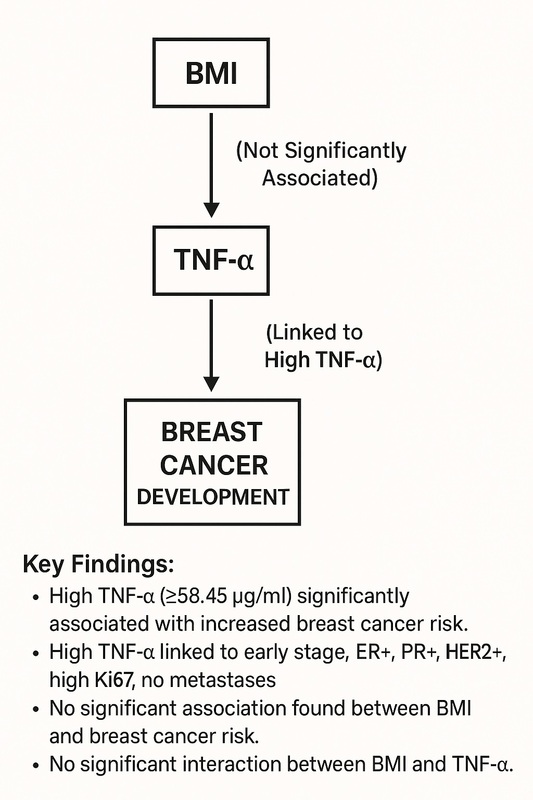Current issue
Archive
Manuscripts accepted
About the Journal
Editorial office
Editorial board
Section Editors
Abstracting and indexing
Subscription
Contact
Ethical standards and procedures
Most read articles
Instructions for authors
Article Processing Charge (APC)
Regulations of paying article processing charge (APC)
ONCOLOGY / RESEARCH PAPER
The Role of BMI and TNF-α in Breast Cancer Development: A Case‒Control Study
1
1Department of Health Toxicology, School of Public Health, China Medical University (Shenbei Campus), No.77, Puhe Road, Shenbei New District, Shenyang, Liaoning Province, 110122, China, China
2
3Community Health Management Center, Shenzhen Pingle Orthopedics Hospital, No.15, Lanjin 4th Road, Pingshan District, Shenzhen City, 518188, China, China
3
Department of Epidemiology, School of Public Health, Sun Yat-sen University (North Campus), No.74, Zhongshan 2nd Road, Yuexiu District, Guangzhou City, Guangdong Province, 510080, Chin, China
Submission date: 2025-02-13
Final revision date: 2025-04-18
Acceptance date: 2025-04-26
Online publication date: 2025-06-22
Corresponding author
Zefang Ren
Department of Epidemiology, School of Public Health, Sun Yat-sen University (North Campus), No.74, Zhongshan 2nd Road, Yuexiu District, Guangzhou City, Guangdong Province, 510080, Chin, China
Department of Epidemiology, School of Public Health, Sun Yat-sen University (North Campus), No.74, Zhongshan 2nd Road, Yuexiu District, Guangzhou City, Guangdong Province, 510080, Chin, China
KEYWORDS
TOPICS
ABSTRACT
Introduction:
A high body mass index (BMI) is closely linked to increased breast cancer risk. Despite the established links between BMI and TNF-α with breast cancer, few studies have explored their combined effects on breast cancer development. The aim of our study was to evaluate the separate and combined associations of BMI and tumor necrosis factor-alpha (TNF-α) with breast cancer risk.
Material and methods:
This study conducted a case‒control analysis involving 794 women diagnosed with breast cancer and 268 age‒matched healthy controls from Sun Yat-sen University's affiliated hospitals between October 2008 and March 2018. Data on demographic characteristics, clinical features, and TNF-α levels were collected. Logistic regression models were used to calculate odds ratios (ORs) and 95% confidence intervals (CIs) for the associations between BMI, TNF-α, and breast cancer risk.
Results:
High levels of TNF-α (≥58.45 µg/ml) were significantly associated with an increased risk of breast cancer (OR 1.500; 95% CI 1.112–2.022). Elevated TNF-α levels are linked to early clinical stage, ER-positive, PR-positive, HER2-positive, high Ki67 expression, and the absence of lymphatic and distant metastases. No significant association was found between BMI and breast cancer risk (OR 0.947; 95% CI 0.685–1.310), nor was there a significant interaction effect between BMI and TNF-α.
Conclusions:
TNF-α plays a significant role in breast cancer development, particularly in early clinical stages, and in specific pathological features. BMI alone is not a significant predictor of breast cancer risk. These findings underscore the importance of TNF-α as a potential target for breast cancer prevention and treatment strategies.
A high body mass index (BMI) is closely linked to increased breast cancer risk. Despite the established links between BMI and TNF-α with breast cancer, few studies have explored their combined effects on breast cancer development. The aim of our study was to evaluate the separate and combined associations of BMI and tumor necrosis factor-alpha (TNF-α) with breast cancer risk.
Material and methods:
This study conducted a case‒control analysis involving 794 women diagnosed with breast cancer and 268 age‒matched healthy controls from Sun Yat-sen University's affiliated hospitals between October 2008 and March 2018. Data on demographic characteristics, clinical features, and TNF-α levels were collected. Logistic regression models were used to calculate odds ratios (ORs) and 95% confidence intervals (CIs) for the associations between BMI, TNF-α, and breast cancer risk.
Results:
High levels of TNF-α (≥58.45 µg/ml) were significantly associated with an increased risk of breast cancer (OR 1.500; 95% CI 1.112–2.022). Elevated TNF-α levels are linked to early clinical stage, ER-positive, PR-positive, HER2-positive, high Ki67 expression, and the absence of lymphatic and distant metastases. No significant association was found between BMI and breast cancer risk (OR 0.947; 95% CI 0.685–1.310), nor was there a significant interaction effect between BMI and TNF-α.
Conclusions:
TNF-α plays a significant role in breast cancer development, particularly in early clinical stages, and in specific pathological features. BMI alone is not a significant predictor of breast cancer risk. These findings underscore the importance of TNF-α as a potential target for breast cancer prevention and treatment strategies.
Share
RELATED ARTICLE
We process personal data collected when visiting the website. The function of obtaining information about users and their behavior is carried out by voluntarily entered information in forms and saving cookies in end devices. Data, including cookies, are used to provide services, improve the user experience and to analyze the traffic in accordance with the Privacy policy. Data are also collected and processed by Google Analytics tool (more).
You can change cookies settings in your browser. Restricted use of cookies in the browser configuration may affect some functionalities of the website.
You can change cookies settings in your browser. Restricted use of cookies in the browser configuration may affect some functionalities of the website.



